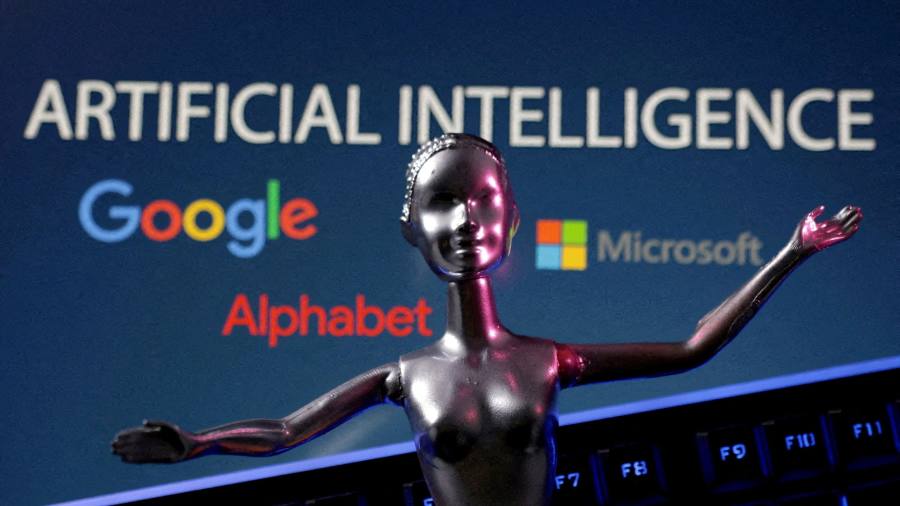Receive free Technology sector updates
We’ll send you a myFT Daily Digest email rounding up the latest Technology sector news every morning.
Microsoft and Alphabet, Google’s parent, reported greater resilience than expected in their core businesses in the second quarter, helping to underpin Big Tech’s recent stock price gains as both companies cautioned about higher AI spending ahead.
The recovery in Google’s digital advertising operations, along with a solid performance in Microsoft’s cloud business at a time when many customers are looking to streamline spending because of economic uncertainty, lifted the companies’ revenue above Wall Street’s expectations. A rare round of job cuts that swept through the biggest tech companies early this year also boosted profit margins.
The news lifted Google’s shares by 6 per cent in after-market trading, taking their gain this year to 46 per cent. Microsoft’s stock, which had risen a similar amount as Big Tech’s share price surge accounted for most of Wall Street’s advance this year, fell back nearly 4 per cent on profit-taking.
Both companies pointed to higher spending in the coming quarters as they build out the data centres needed to support an expected boom in demand for new generative AI services. Facing a barrage of questions from Wall Street, however, executives at both companies stopped short of putting a figure on the capital spending binge to come, or predicting how strong the revenue uplift from AI might be.
Microsoft, which seized a head start in generative AI thanks to its long relationship with OpenAI, said the new technology had added 1 percentage point to the growth of its Azure cloud platform in the latest quarter and would add 2 points in the current period.
Chief executive Satya Nadella called these “material numbers”, given the large size of Microsoft’s cloud business. In a rare disclosure about the scale of Azure, he said that revenue from Microsoft’s cloud business had climbed to $111bn in the fiscal year that ended in June, with Azure accounting for more than 50 per cent for the first time.
However, chief financial officer Amy Hood said that a revenue lift from new AI services such as the “co-pilot” features being added to Office software, would not show through until after the end of this year. She also said that capital spending would rise each quarter over the next year as the software company seeks to match its higher spending to the pick-up in revenue growth from AI.
Meanwhile, Ruth Porat, Alphabet’s CFO, said the search company expected “elevated levels of investment in our technical infrastructure, and that would be increasing through the back half of 2023 . . . then continuing to grow into 2024”. AI was the “primary driver” of the higher costs, she added, as Alphabet adds data centre capacity, buys GPUs and invests in its own TPU accelerator chips.
Despite the coming spending binge on AI, Alphabet and Microsoft both promised careful attention to costs after recent job cuts. Porat said the internet company remained “very focused on durably re-engineering our cost base”, most clearly evidenced by the cuts and a slowdown in hiring. The company’s headcount fell by nearly 9,000 in the latest three months, though at 181,798 it was still 5 per cent higher than a year before.
The new cost discipline lifted Alphabet’s operating profit margin to 35 per cent, or 2 points higher than expected, from 30 per cent in the preceding three months. Like Microsoft, its margins were also boosted by a change in the estimated life of its data centre equipment that resulted in lower depreciation charges.
Alphabet was buoyed by a 5 per cent increase in Google’s search and other advertising, a rebound from the meagre 2 per cent growth of the first quarter. Overall revenue grew 7 per cent to $74.6bn, ahead of estimates for $72.8bn. The higher profit margin lifted net income to $18.4bn, well ahead of the $16.9bn expected by Wall Street.
Microsoft also reported revenue and earnings ahead of Wall Street’s expectations, despite a further deceleration in the growth of its Azure cloud platform as customers seek to increase the efficiency of their cloud spending.
Azure growth slowed to 27 per cent in constant currency terms in the latest period, at the top of end of the company’s guidance but down from 31 per cent in the first three months of 2023 and 46 per cent a year ago. Microsoft has attributed the slowdown to efforts by customers to “optimise” their spending in the face of economic uncertainty.
The latest results were boosted by 17 per cent growth in revenue from Office 365, a point ahead of Microsoft’s forecast, reflecting the shift of customers to the higher-paying E5 version of the software.
Overall, Microsoft reported revenue of $56.2bn, up 8 per cent from a year before, while earnings per share rose 21 per cent to $2.69. Wall Street had been expecting revenue of $55.4bn and earnings of $2.55 a share.
Read the full article here














